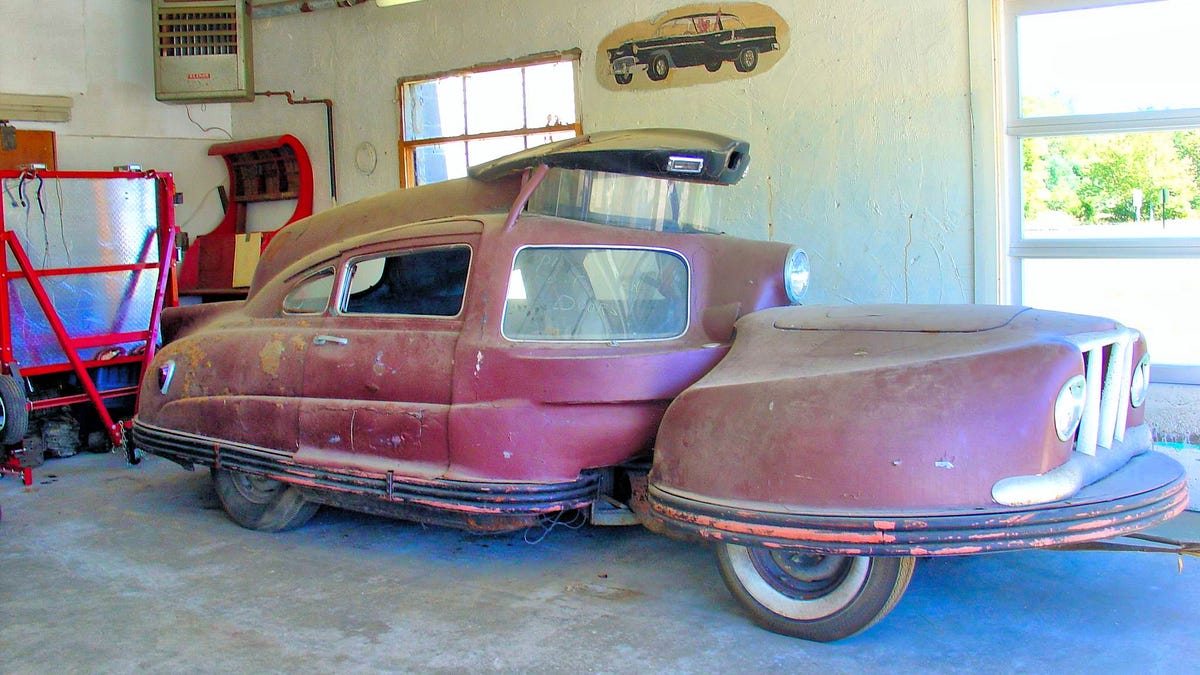The Split-in-Two Super Safe Hudson 'Sir Vival' to Be Rehabbed

The Lane Motor Museum is planning to breath new life into its latest acquisition, another true piece of automotive history: the Sir Vival. Once touted as the safest car ever built, the Sir Vival was an incredible, extremely weird-looking concept vehicle with visions of safety during a time of mass death on American roads.
Ed Moore of Bellingham Auto Sales considered his shop to be the last operating Hudson dealership in the world since he and his family have managed to sell a Hudson a year since the brand went belly up in the ‘50s. Moore announced he’d be closing up that shop however, (no one tell Hudson, it would crush them) last year and would pass on stewardship of this automotive oddity on to a worthy collector. That’s where Jeff Lane of Lane Motor Museum comes in, according to Hemmings. The history of Bellingham Auto Sales and its connection to the creation of the Sir Vival is fascinating:
In 1958, Worcester-based Walter Jerome decided it was about time somebody built a car designed primarily for safety and not for looks or speed. Rapidly increasing numbers of highway deaths – especially in the postwar period – led many to call for greater automotive safety as early as 1947, but the response from Detroit was tepid at best throughout the Fifties. Ford made a few gestures at improving automotive safety, including funding a study on safety cars at Cornell, but it largely fell to independents and individuals to build cars with safety features designed into the vehicle.
Jerome decided to start with a step-down Hudson – which he bought from Bellingham – and split it into two sections “to anticipate the possibility of collision from any angle.” Similar to Bela Barenyi’s idea for the crumple zone, Jerome intended the front section, mounted via a hinge to the rear section, to absorb a collision rather than deflect one, noting that the rigidity of typical cars was what led to injuries and deaths in collisions. To each of the two sections, Jerome added steel bumpers that acted, in his words, like a second frame, and rubber bumpers around the steel designed to redirect all but direct collisions. Yes, he built a full-size bumper car.
Walter C. Jerome spent a decade building the Sir Vival out of a 1948 Hudson, it was first featured in the April 1959 issue of Mechanix Illustrated. The wacky two-part design was all part of the plan, as it meant that the engine would take the force of a head on collision, while the passenger compartment was angled away from the force of the crash. The turret shaped driver compartment offered a 360-degree view of the road, and the Sir Vival was fitted with bright lights for maximum safety.
Jerome wasn’t wrong of course. In the post-war years, the auto industry even had a motto that sounds crazy to us today: “Safety doesn’t sell.” And as Automotive News noted in a 1996 story, there were no federal safety regulations, nor were consumers demanding safer cars en masse. From Hemmings:
“It is all too obvious that Detroit has no plans to come up with anything really new,” Jerome wrote. “Their 1964 cars are already on the drawing boards and spring from the same rigid frames. I hold that human life is important, far more important than Detroit’s worry about the cost of retooling to produce an automobile which will save human lives. Adoption of the flexible Sir Vival design would make rigid vehicles obsolete and create a new market, almost immediately, for 65 million vehicles.”
G/O Media may get a commission
Jerome didn’t get quite that market. He ended up only building the one Sir Vival and when he died, the Sir Vival went back to its original home, the Bellingham Auto Sales.
While the approach may be strange, he wasn’t wrong about the amount of violent death occurring to this day on America’s roads. It was 1946 when car crash deaths in the U.S. first crested 30,000 per year, and that number, while ebbing and rising a bit year by year, never significantly dropped back down. By 1963, traffic fatalities breached 40,000 a year. It wasn’t until two years later when Ralph Nader published Unsafe At Any Speed, that there was any discussion of enforcement of safety standards in the auto industry. The results were the National Traffic and Motor Vehicle Safety Act of 1966 and the Highway Safety Act of 1966 which laid down the first mandatory federal safety standards for motor vehicles.
Lane hopes to get the Sir Vival up and running with minimal restoration if possible, as it is in generally good shape though hasn’t run since 1965.



